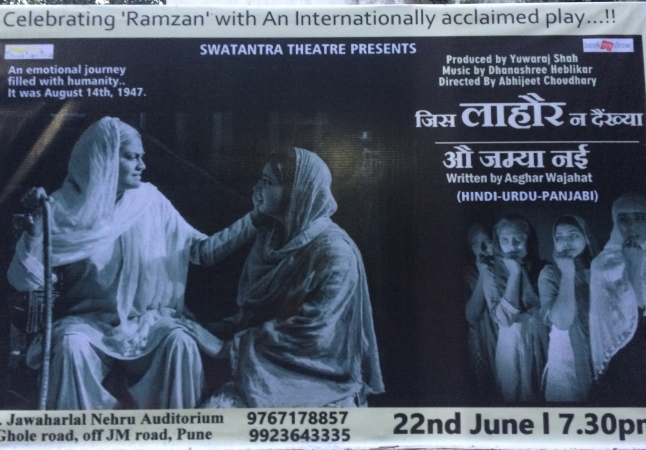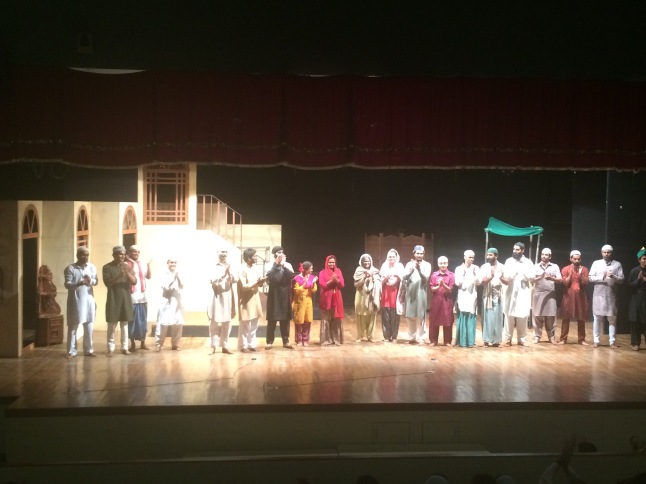मध्ये मी प्रसिद्ध लेखिका इस्मत चुगताई यांचा एक कथा संग्रह रजई यांचे मराठी भाषांतर वाचत होतो. त्यातील प्रसिद्ध आणि त्याकाळी अतिशय अशी वादग्रस्त कथा रजई ही वाचत होतो. ही कथा समलिंगी संबंधावर आहे. हा कथा संग्रह १९४० च्या आसपास प्रसिद्ध झाला, म्हणजे स्वातंत्र्यपूर्व काळात. त्यावेळेस त्यांना लाहोर मधील कोर्टाने समन्स बजावून तेथे खटला चालवला. त्यांना तेथे जावे लागले होते, त्या सर्व अनुभवांबद्दल, जिंदादिल लाहोर शहराबद्दल लिहून ठेवले आहे. स्वातंत्र्यपूर्व काळातील भारतातील पंजाब प्रांताची लाहोर तशी राजधानी, मोठे आणि प्रसिद्ध शहर. व्यापार, संगीत, संस्कृती यांचे केंद्र. पंडित विष्णू दिगंबर पलुस्कर यांनी गांधर्व महाविद्यालयाची स्थापना लाहोर मध्ये केली होती. १९४७ मध्ये फाळणी झाली आणि पंजाब प्रांत विभागाला गेला, आणि लाहोर पाकिस्तानात गेले. फाळणीची आणि लाहोर शहराची पार्श्वभूमी असलेले एक नाटक बऱ्याच वर्षांपासून ऐकत आलो होतो. त्याचे नाव जिस लाहौर न देंख्या औ जम्या नई. ते पाहायचा काल योग आला.

Jis Lahore Na Dekhya Ou Jamya Nai
कालचा हा प्रयोग स्वतंत्र थिएटरने सादर केला. पुण्यातील ही संस्था हिंदी नाटकं प्रामुख्याने करते. तसे पाहिले तर ‘जिस लाहौर नही…’ हे नाटक १९८९ मधील. असघर वजाहत यांनी ते लिहलेले उर्दू, पंजाबी, हिंदी भाषेतील हे नाटक. हा प्रयोग झाला घोले रस्त्यावरील नेहरू सांस्कृतिक केंद्रात. प्रेक्षकांत बरीच मंडळी पंजाबी, सिंधी, काही मुस्लीम, अमराठी भाषिक दिसत होती. मी मुद्दामच हे निरीक्षण करत होतो. नाटकाचा विषयच तसा आहे. हिंदुस्तानाची फाळणी होऊन भारत आणि पाकिस्तान हे देश जन्माला आले. लाहोर पाकिस्तानात गेले. मुस्लीम लोकांची पाकिस्तानात जाण्याची धडपड, तर हिंदूंची भारतात. दंगे, लुटालूट, जाळपोळ, धार्मिक हिंसाचार दोन्ही बाजूला झाला, जवळपास एक-दीड कोटी लोकसंख्या बाधित झाली. या निमित्ताने अनेक दारुण कहाण्या विविध रूपात आल्या आहेत. हे नाटक म्हणजे लखनौ मधून लाहोर मध्ये फक्त जिवानिशी स्थलांतरित होऊन आलेल्या एका मुस्लीम कुटुंबाची कहाणी.
या कुटुंबाला शरणार्थी शिबिरात राहिल्यानंतर, सरकारतर्फे स्थलांतरित मुस्लीम लोकांना घरवाटप योजनेत लाहोर शहरातील मधील एक घर दिले गेले असते. ते त्या घरी आले असता त्यांना समजते की घरात एक पंजाबी बोलणारी हिंदू वृद्ध महिला अजून राहत असते, कारण ते तिचे घर असते, ती दंग्यातून बचावली गेली असते. तिचा मुलगा, आणि इतर कुटुंबियांचा पत्ता नसतो. त्या मुस्लीम कुटुंबाचे धाबे दणाणते. काय करावे समजत नाही. आधी सुरुवातीला नकार, तीला घराबाहेर काढून, भारतात जाण्यासाठी छावणीत रवानगी करण्यापासून, गुंडांकरवी तिची हत्या करण्याचे विचार त्यांच्या मनात येतात. तीला अर्थातच लाहोर मध्येच राहायचे असते, भारतात जायचेच नसते. कालांतराने, माणुसकीच्या नात्याने तिच्या सर्वांना मदत करण्याच्या स्वभावामुळे, ती त्यांच्यात मिसळून जाते, आणि जिव्हाळा, ओलावा निर्माण होतो. ती त्या कुटुंबातील एक आजी होते. हे सर्व छोट्या छोट्या प्रसंगातून छान फुलवले आहेत.
काही दिवसांत दिवाळी आलेली असते. लाहोर मधील मुस्लीम घरात दिवाळी साजरी केली जाते, हा मोठा वादंगाचा विषय होऊन जातो. मुस्लीम कुटुंबाला त्रास दिला जातो. या सर्वांची परिणीती ती आजी घर सोडून जाण्यात होते, पण तीला परत आणले जाते. आणि मग एके दिवशी तिचे वृद्धापकाळाने निधन होते. मग तिच्या अंत्यसंस्काराचा विषय निघतो, आणि परत वितंडवादाला तोंड फुटते. मौलवीच्या सल्ल्यानुसार हिंदू पद्धतीनुसारच तिचे अंत्यसंस्कार करावे असे ठरते. याचा निषेध म्हणून त्यामुळे गुंडांकरवी तो मौलवी मारला जातो. आणि मग नाटक संपते ते आजीची अंत्ययात्रा सुरु करून, आणि दुसरीकडे त्या मौलवीचा जनाजा काढून.
नाटकात अर्थात उर्दू, आणि पंजाबी भाषेचा भरणा आहे. उर्दू भाषेचा लहजा, गोडवा कित्येक वर्षांनी कानावर पडला. मी ९-१० वर्षांपूर्वी उर्दू भाषा शिकत होतो, त्यावेळची आठवण झाली. ठिकठिकाणी शेरो-शायरी, टाळ्या घेणारी वाक्ये, संवाद यामुळे सर्व वातावरण भारून जाते. नाटकाचा संदेश अर्थातच धार्मिक सलोखा राखण्याचा, एकमेकांचा आदर, इन्सानियत ह्या दृष्टीकोनातून पाहण्याचा आहे. त्यातच आपापल्या शहरांच्या, गावाच्या आठवणी, त्यात रमणे, ह्या सर्वांमुळे प्रेक्षक नाटक डोक्यावर घेतात. प्रत्येकाला आपल्या गावाची ओढ असतेच, कुठल्याही धर्माचे, भाषेचे असा. नाटक संपल्यावर सर्व कलाकारांनी अभिवादन केले, त्यातील काही जणांनी मनोगत व्यक्त केले. प्रेक्षकातून कोणाला बोलायचे असल्यास, प्रतिक्रिया द्यायची असल्यास, ती देऊ शकता असे सांगितल्यावर, एका महिलेने, जिचे मूळ गाव लखनौ आहे, तिने हे नाटक म्हणजे तिची कथाच आहे हे नमूद केले.

जिस लाहौर न देख्या औ जम्या नई
आता नाटकाच्या शीर्षकाचा अर्थ असा आहे की ज्याने लाहोर पहिले नाही, तो जन्माला येऊन सुद्धा नसल्यासारखा आहे, अशी लाहोर शहराची थोरवी गाणारा असा आहे. या निमित्ताने तरी तेथे जाऊन आले पाहिजे!




